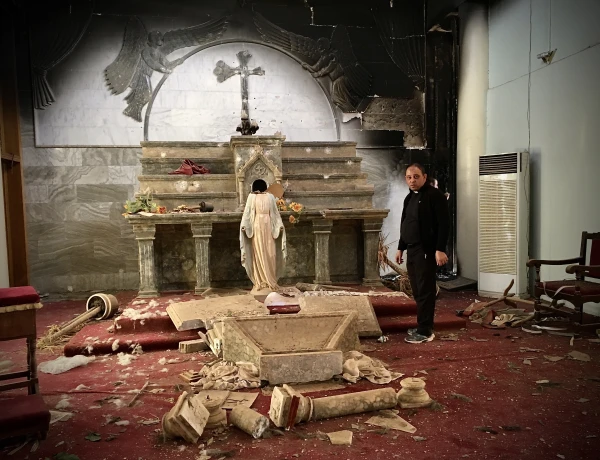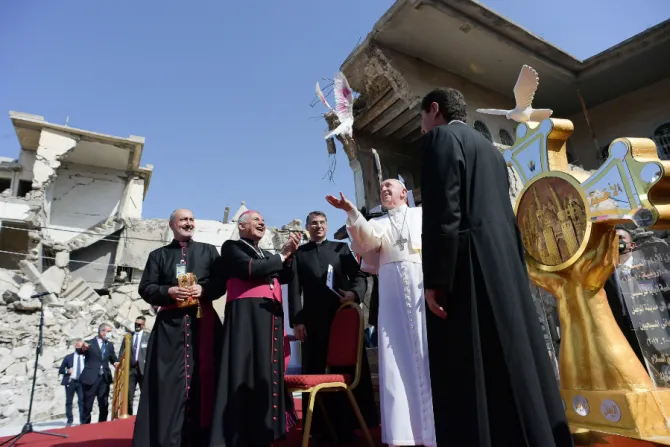New York City, New York, Apr 2, 2022 / 05:00 am
Most of their fellow believers around the world scarcely know they exist. But once you meet the Christians of the Nineveh Plains of northern Iraq, you will not forget them.
“Francis in Iraq,” a new documentary by Stephen Rasche about Pope Francis’ historic visit to the country on March 5-8, 2021, provides a memorable introduction.
It took courage, and no little amount of trust in God’s providence, for the then-84–year pontiff to undertake such a taxing journey, coming as it did amid a still-perilous pandemic and legitimate concerns for his security and health.
No pope had ever visited Iraq. Pope John Paul II hoped to do so, but was never able to go. Francis seized the opportunity, calling the trip “a duty to the land that has been martyred for so many years."
Though there is plenty of footage from his visit, the film’s title, it bears noting, is something of a tease. That’s because the real protagonist isn’t the pope; it’s the long-suffering people he came to see.
One of Francis’ legacies will be his challenge to the Church to bring God’s love and mercy to the margins of society. But “marginalized” doesn’t begin to do justice to these Chaldean and Syriac Catholics and the region’s other Christian minorities, whose plight has been largely ignored by the outside world.
They’ve endured church bombings, suicide attacks, genocide, war, and still more war. And that only covers the past few, sorrowful decades in the centuries-long saga of these ancient faith communities, which can trace their origins to the time of the apostles.
‘Get out or we will kill you’
At the start of “Francis in Iraq,” we see something deeper than sorrow in the haunting facial expression of one of the film’s main subjects, Father Thabet Habib Al Mekko, a Chaldean Catholic priest who became a bishop in 2021.
It is November 2016. Just days before, Islamic State fighters were driven off after a fierce battle that has reduced to rubble Al Mekko’s village of Karamless, located less than 20 miles southeast of Mosul, the center point of the crescent-shaped Nineveh Plains region. The damage we see is so severe, it is difficult to imagine that anything but a quarry ever existed in this place, or ever would again.
Wending his way through the ruins, Al Mekko arrives at what remains of his parish, St. Addai Church. Waiting for him in front of the altar is a statue of the Blessed Mother, standing upright, its head decapitated and hands severed. The unspoken message of this surgical desecration is rendered more explicitly by some ISIS graffiti, left in a Catholic church in another town, Batnaya, whose own statue of Mary has met with an identical fate.
“Oh you slaves of the cross, there is no place for you in the land of Islam,” the graffiti said, in German. “Either get out of here or we will kill you.”

The composition of this sad scene is something an accomplished painter might have conceived.
The interior of the ransacked church is edged in darkness, but a dim, natural light shines on the toppled altar and broken pieces of marble at Mary’s feet, in the center of the frame. The statue’s hand-less arms are outstretched, as if to say, “See what they've done,” but our attention is drawn to the empty space where Mary’s head ought to be. To the right of the statue, we see that same emptiness written on the face of St. Addai’s speechless pastor, who looks toward the camera.
What now?, we can imagine him thinking just then. Where does one even begin to rebuild after such loss?
(Story continues below)
But as “Francis in Iraq” goes on to show, Karamless is rebuilt, thanks in no small measure to Rasche’s close friend and collaborator, the late Andrew Walther, to whom the film is dedicated.
It was Walther, then vice president of communications and strategic development for the Knights of Columbus, who helped engineer a $2 million donation from the Knights to get the town’s reconstruction underway. Walther later served as president of EWTN News prior to his unexpected death in 2020 at age 45.
It’s that rebuilding process, both material and spiritual, that is the chief concern of Rasche’s documentary. News of the pope’s visit arrives in the midst of this years-long struggle, a tangible sign that the heroic witness of these courageous Christians hasn’t been ignored.
Pope Francis’ words at the joyous Mass in Erbil provided further affirmation: “Today, I can see at first hand that the Church in Iraq is alive, that Christ is alive and at work in this, his holy and faithful people.”
Iraqi Christians 'are still there'
“Francis in Iraq” premiered on March 22 at the Sheen Center for Thought & Culture in New York City. Rasche attended the event, co-sponsored by the National Review Institute, along with Cardinal Timothy Dolan of New York, Archbishop Gabriele Giordano Caccia, the Holy See’s permanent observer at the United Nations, and Walther’s wife, Maureen Walther.
In his remarks prior to the film’s showing, Dolan noted that though the world’s attention is rightly focused on the war in Ukraine, the plight of innocent people in other parts of the world who are persecuted for their faith must not be overlooked. He said the film shows Pope Francis bringing the Gospel message and the "healing balm" of Jesus' mercy to one of those places.
Caccia, in his remarks, couched Francis’ visit to Iraq in the broader themes of his pontificate: “genuine fraternity,” peaceful co-existence, mercy, and forgiveness.
“Pope Francis went to Iraq to praise, comfort, and strengthen the Iraqis who are giving true brotherhood a chance. He went to focus the attention of the world on their many needs,” the archbishop said.
“But he was also hoping that the challenging lessons he was giving there, as he stood amid the skeletons of buildings, dangling concrete staircases, and treasured ancient churches, would be learned by people everywhere.”
In a question-and-answer session after the film moderated by Kathryn Jean Lopez, a senior fellow at the National Review Institute, Rasche described how the documentary project evolved over the course of six years.
“You know, when we first started going into the towns, there was just a very small crew of us, it was usually no more than two or three priests, and then myself. And it was a very difficult thing, sometimes, to be there, and be the person that needed to document what was going on,” he recalled.
Once the shock of what they were witnessing subsided, Rasche and his crew recognized they had a responsibility to share the story of the faith and resiliency of these little-known Christians.
“With the situation of the statue of Mary, I remember that day very clearly,” Rasche said.
“When we found the face of Mary, I was actually the one who carried it back to the car. And I remember holding her face in my hands looking at it,” he said. “And it was very clear that we were being called to do something.”

Rasche told Lopez that his favorite scene in the film comes after the statue is discovered in the church, when parishioners of the church in Batnaya celebrate their first Easter Sunday together in three years. Their carefree smiles belie the ordeal they’ve just survived.
“The windows are still blown out, and there’s still bullet holes everywhere,” Rasche pointed out. “And yet the people are just so grateful to be together as human beings.” What struck him most, he said, was “the feeling of hope that was there.”
“Francis in Iraq” will be going on tour, with more details to be released soon, Rasche said. The Knights of Columbus provided funding for the film.
He told Lopez that he hopes the documentary raises awareness of the precarious state of the Catholics and other Christian minorities in northern Iraq. In the past two decades, their numbers have dwindled from more than 1 million to some 200,000 today. Meanwhile, approximately 70,000 refugees from the region are still living in Lebanon, Turkey, and Jordan, Rasche said.
Chaldean Catholic Archbishop Bashar Matti Warda of Erbil, who also appears in the documentary, expressed that same hope in a video message shown after the film’s conclusion.
“In this film we have tried to show not just the outward events of the visit of Pope Francis, but [also] to show the hearts and minds of our people … our hopes, our fears, the realities which we still face, and the joy which remains in our hearts,” Warda said.
“The courageous visit of His Holiness to Iraq has let the world know that we Christians are still there, doing everything in our power to remain in our land, through our service to others and through our joy in our faith,” Warda said.
“We hope that your knowledge of our long journey can give you courage and strength on your own path, wherever it may lead, and that you will remember us in your prayers, as we will remember you,” he concluded. “God bless you all.”






